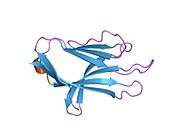NCR2
Natural cytotoxicity triggering receptor 2 is a protein that in humans is encoded by the NCR2 gene.[2][3] NCR2 has also been designated as CD336 (cluster of differentiation 336).
References
- ↑ "Human PubMed Reference:".
- ↑ Cantoni C, Bottino C, Vitale M, Pessino A, Augugliaro R, Malaspina A, Parolini S, Moretta L, Moretta A, Biassoni R (Jun 1999). "NKp44, a triggering receptor involved in tumor cell lysis by activated human natural killer cells, is a novel member of the immunoglobulin superfamily". J Exp Med. 189 (5): 787–96. doi:10.1084/jem.189.5.787. PMC 2192947
 . PMID 10049942.
. PMID 10049942. - ↑ "Entrez Gene: NCR2 natural cytotoxicity triggering receptor 2".
Further reading
- Hershkovitz O, Jivov S, Bloushtain N, et al. (2007). "Characterization of the recognition of tumor cells by the natural cytotoxicity receptor, NKp44.". Biochemistry. 46 (25): 7426–36. doi:10.1021/bi7000455. PMID 17536787.
- Forte P, Lilienfeld BG, Baumann BC, Seebach JD (2005). "Human NK cytotoxicity against porcine cells is triggered by NKp44 and NKG2D.". J. Immunol. 175 (8): 5463–70. doi:10.4049/jimmunol.175.8.5463. PMID 16210654.
- Fuchs A, Cella M, Kondo T, Colonna M (2005). "Paradoxic inhibition of human natural interferon-producing cells by the activating receptor NKp44.". Blood. 106 (6): 2076–82. doi:10.1182/blood-2004-12-4802. PMID 15941912.
- Poggi A, Massaro AM, Negrini S, et al. (2005). "Tumor-induced apoptosis of human IL-2-activated NK cells: role of natural cytotoxicity receptors.". J. Immunol. 174 (5): 2653–60. doi:10.4049/jimmunol.174.5.2653. PMID 15728472.
- Nowbakht P, Ionescu MC, Rohner A, et al. (2005). "Ligands for natural killer cell-activating receptors are expressed upon the maturation of normal myelomonocytic cells but at low levels in acute myeloid leukemias.". Blood. 105 (9): 3615–22. doi:10.1182/blood-2004-07-2585. PMID 15657183.
- Campbell KS, Yusa S, Kikuchi-Maki A, Catina TL (2004). "NKp44 triggers NK cell activation through DAP12 association that is not influenced by a putative cytoplasmic inhibitory sequence.". J. Immunol. 172 (2): 899–906. doi:10.4049/jimmunol.172.2.899. PMID 14707061.
- Mungall AJ, Palmer SA, Sims SK, et al. (2003). "The DNA sequence and analysis of human chromosome 6.". Nature. 425 (6960): 805–11. doi:10.1038/nature02055. PMID 14574404.
- Cantoni C, Ponassi M, Biassoni R, et al. (2004). "The three-dimensional structure of the human NK cell receptor NKp44, a triggering partner in natural cytotoxicity.". Structure. 11 (6): 725–34. doi:10.1016/S0969-2126(03)00095-9. PMID 12791260.
- Augugliaro R, Parolini S, Castriconi R, et al. (2003). "Selective cross-talk among natural cytotoxicity receptors in human natural killer cells.". Eur. J. Immunol. 33 (5): 1235–41. doi:10.1002/eji.200323896. PMID 12731048.
- Eapen BR (2003). "A new insight into the pathogenesis of Reiter's syndrome using bioinformatics tools.". Int. J. Dermatol. 42 (3): 242–3. doi:10.1046/j.1365-4362.2003.01704.x. PMID 12653925.
- Allcock RJ, Barrow AD, Forbes S, et al. (2003). "The human TREM gene cluster at 6p21.1 encodes both activating and inhibitory single IgV domain receptors and includes NKp44.". Eur. J. Immunol. 33 (2): 567–77. doi:10.1002/immu.200310033. PMID 12645956.
- Cantoni C, Ponassi M, Biassoni R, et al. (2003). "Crystallization and preliminary crystallographic characterization of the extracellular Ig-like domain of human natural killer cell activating receptor NKp44.". Acta Crystallogr. D. 58 (Pt 10 Pt 2): 1843–5. doi:10.1107/S0907444902012325. PMID 12351833.
PDB gallery |
|---|
|
| 1hkf: THE THREE DIMENSIONAL STRUCTURE OF NK CELL RECEPTOR NKP44, A TRIGGERING PARTNER IN NATURAL CYTOTOXICITY |
|
|
External links
|
|---|
|
| 1-50 | |
|---|
|
| 51-100 | |
|---|
|
| 101-150 | |
|---|
|
| 151-200 | |
|---|
|
| 201-250 | |
|---|
|
| 251-300 | |
|---|
|
| 301-350 | |
|---|




 . PMID 10049942.
. PMID 10049942.